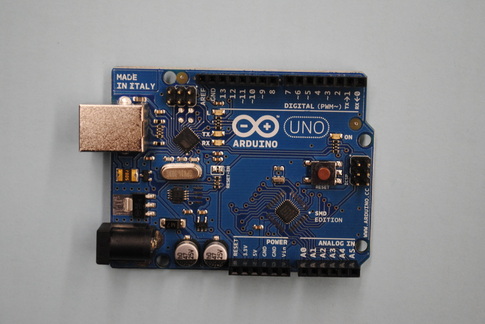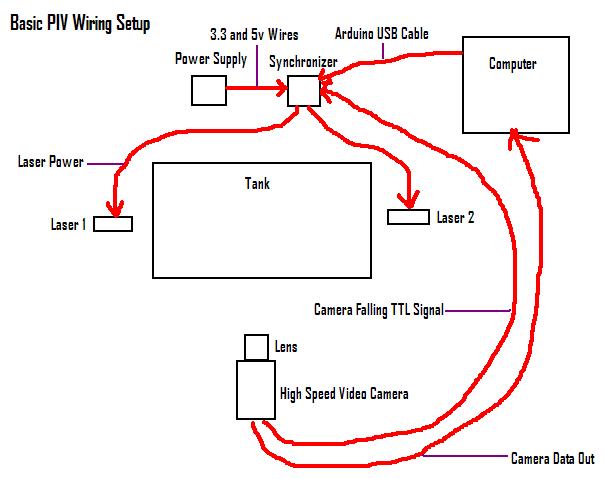You can now download my thesis that includes much more detail on how to build an economical and open-source DPIV instrument HERE.
Please download PIVlab for the software to analyze images:
Basic Parts of a PIV System:
Transparent tank or chamber, fluid, power supplies, laser light at 532nm (Green) or 650nm (Red), optics, isobuoyant particles ranging in size from 20µm-100µm, sieve system, high speed camera and lenses, microprocessor (synchronizer) and protoshield, computer, PIV software, electronics, wires, and tools.
Basic PIV Setup:

A graphic of this DPIV instrument along with the components necessary for calibration: 1. A desktop computer, 2. A high-speed camera filming at 125 frames per second, 3. A microprocessor used for synchronizing the camera to the laser pulse, 4. A benchtop power supply, 5. A 0.8 W, diode-pumped, solid-state, frequency-doubled, and made of neodymium-doped yttrium aluminum vanadate and potassium titanyl phosphate laser, 6. A cylindrical laser lens mounted on the laser, created a vertical 2-D light sheet about 0.002 m thick, 7. A 0.002 m wide vertical paper aperture was mounted on the sides of the aquarium to absorb any stray light beams, 8. The laser sheet, 9. A 0.01 m grid paper used for distance calibration, 10. An aquarium that was 0.41 m x 0.21 m x 0.25 m, 11. A dual-Syringe Pump, 12. A plastic 6.1 x 10-5 m3 syringe, with an inside diameter of 0.026 m, 13. Clear vinyl tubing, 14. A glass ejection cylinder with a length of 0.1 m, an internal diameter of 6.25 x 10-3 m and an outside diameter of 7.7 x 10-3 m.
Tanks, Fluid and Power Supplies:

Tanks can be aquariums of glass or plexiglass - $15. The surfaces should be flat to prevent distortion of the laser light and images. The fluid should be distilled water to start out with. Power supplies should not be batteries as to keep the laser light brightness constant - $20. Old PC power supplies can be harvested and retrofitted with a Sparkfun Benchtop Powerboard Kit to supply 3.3, 5, 12 and -12 volt power.
Lasers:

High powered laser pointers are an inexpensive solution to the light requirements for small PIV systems - $50 X 2. These lasers are DANGEROUS to the human eye and can cause retinal damage. Lasers are UltraFire 0.3 - 0.4w, 532nm laser pointers.
Optics:

Optics can be harvested from laser levels, guides and markers to produce a laser light sheet - $5 X 2. Some laser levels have press-fitted optics and are very difficult to remove. Laser marker optics seem to be easier to harvest. Central Machinery laser guides are sold from Harbor Freight Tools.
Neutrally Buoyant Particles:

Particles can be oils, styrofoams, hollow glass spheres, or dehydrated blue-green algae - free - $15. Pliolite, a form of styrofoam is a great particle. Try styrofoam or blue-green algae pills to start out with. A blender will break particles up and a sieve shaker will size the particles between 20µm and 100µm in diameter - $50.
Sieving:

If a sieve shaker is not available, use a set of sieve tubes and place them on a fish tank air pump.
High Speed Camera:

It turns out there are many cameras that can film at frame rates that can collect DPIV video data. The GoPro Hero 5 Black can film up to 240 frames/sec. Jackson et al. in Hedrick's lab have developed a way to use these cameras to film at 240 frames/sec. without having distortion. You can read Jackson's paper. I bought several GoPro Hero 5 Black cameras and used the wifi remote to record from different angles. There are other cameras that can be used in DPIV.
Lenses:

The lens must have a large aperture to allow a maximum amount of light to enter the camera - $100. The focal ratio or
f-number on the camera should be 2.0 or less. 30-80mm lenses seem to work within the space confines of the PIV system.
f-number on the camera should be 2.0 or less. 30-80mm lenses seem to work within the space confines of the PIV system.
Microprocessor:

The microprocessor Arduino can be used as a synchronizer with a ProtoShield - $65. You can download our custom programming (see below).
| Arduino PIV Program | |
| File Size: | 0 kb |
| File Type: | pde |
PIV Software:

A PC or Mac can be used to run the camera and PIV software. PIV software is free! Several universities have written and produced open source PIV software. – Some of these programs require MATLAB or Python to run, some do not:
PIVLAB
OPENPIV
PIVLAB
OPENPIV
How to Build the System: Particles

The particles must be ground in a blender and sieved. The particles then are added to the water. 0.25gPliolite/gallon of water was a good density to start out with. A drop of dish soap sometimes was necessary to allow the particles to mix evenly throughout the tank. The sheets of laser light must be aligned to brighten the particles.
How to Build the System: Electronics

The lasers must have the optics centered directly on the beam. Glue the optics directly in front of the beam. The lasers must be wired to the synchronizer. The synchronizer receives 5v and 12v power. The 5v is then pulsed to the lasers from the camera’s signal. The synchronizer also must have an input from the computer with a USB cable. The signal cable is connected from the camera to the synchronizer.
How to Build the System: Electronics Cont.

The camera must be plugged into the computer and have the signal cable plugged into the synchronizer. An external or internal software trigger may be used. The camera software should be ready to capture the images. The video file needs to be converted to single image files. The single image files are then imported to the PIV software for analysis.
Electronics Schematic:

For those of you that are experienced with electronics schematics, Daniel Kmack drew this for us. Thank you Danny!
If you want to go to the website where the schematic was drawn and modify it, you can! Here's the link: Circuit Link
If you want to go to the website where the schematic was drawn and modify it, you can! Here's the link: Circuit Link
Teacher grants from NSF can be found at:
NSF teacher grants CLICK HERE

